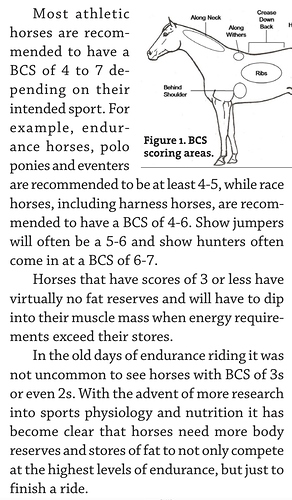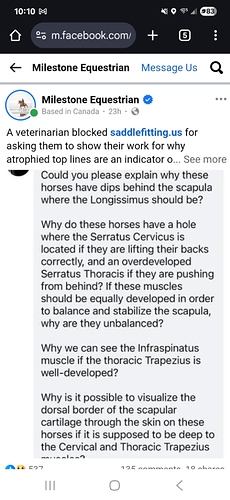I didn’t see the initial video of Sovereignty’s feet because I guess I blocked her, or she blocked me – or we mutually blocked each other  “Call out culture” in the horse world is great for outrage farming and lots of clicks
“Call out culture” in the horse world is great for outrage farming and lots of clicks  – but it doesn’t substitute for a nuanced discussion about horse’s feet, how they live and in what conditions, and how we can make life best for them acknowledging the realities of all of those things. Oh well – enjoy the outrage (and money that comes with it) but don’t think that you are really making life better for horses.
– but it doesn’t substitute for a nuanced discussion about horse’s feet, how they live and in what conditions, and how we can make life best for them acknowledging the realities of all of those things. Oh well – enjoy the outrage (and money that comes with it) but don’t think that you are really making life better for horses.
I just came across her latest 5* event horses all have atrocious top line posts. And I love it cause if you ask to see any horse with a correct top line the arm chair quarterbacks can only send you fluffy who isn’t in work. The whole lot of them can’t produce one horse going above prelim or 1.10 with an “acceptable” top line by their standards.
But the irony for me is why are no sport horse vets talking about this? Only (mostly online) saddle fitters and body workers are declaring a top line epidemic. Mind you these two professions require no formal schooling or standardized boards to call yourself either. So am I supposed to believe the entire field of veterinary medicine is turning a blind eye to the epidemic of top lines and only these horse saviors on the internet are speaking the truth?
Give me a break
I think a lot of armchair quarterbacks struggle with the concept of “perfection.” They learned what is “ideal” at some point, and what they learned is probably correct. But they fail to understand is that “perfection” is a construct that is not actually attainable.
Do some of these horses have imperfections with their toplines? Absolutely. Could those imperfections be improved? Maybe, maybe not. Do those imperfections mean the horse is unfit to perform at that level? Absolutely not.
This. Also the argument of muscle atrophy vs lean muscle. But definition Marathon runners, especially those that don’t strength train on the side all have evidence of muscle atrophy in their fast-twitch muscles.
Sinead recently interviewed Buck on In Stride and I think the conversation regarding different formats in really enlightening, especially for someone who doesn’t have the exposure to UL to understand how it influences the sport and effects the horses. Really thought provoking. I encourage anyone who’s curious to listen to it.
Many thoroughbreds have shark fin withers but their backs aren’t bony. Racehorses are prime examples of this, they can be lean but their backs don’t look like some eventers. Maybe it’s age that also gives them a bit of a hollow appearance.
Years ago you would see super lean endurance horses, but not so much anymore. I think they’ve learned a horse needs some body reserves to keep going.
Ugh, that chick going on and on about the “topline atrophy” in the jog like a dog with a bone. Her stuff popped up on my feed again a day or two ago, this time still going on about it and claiming her pet OTTB is much healthier because it doesn’t have “atrophy.” Complete with a photo in the comments of the horse in pasture potato condition, with minimal topline and a bushy mane filling in the hollow in front of the withers while she claimed the horse looked soooo much better than the horses in the Kentucky jog.
I also find it interesting that for all the content and videos she shares of her riding “before she saw the light,” there are never any recent videos showing the “right way” to ride, only a handful of carefully selected still photos. Almost like she knows that any video can be screenshotted at the wrong moment and claimed to be a “pain face” or show the horse’s mouth open or nose slightly behind vertical or such keyboard warrior fare.
I think most people also don’t know that horses can lose 40lbs on XC day. There was a nutrition/feed study done by Rutgers in the mid 00s at Jersey Fresh CCI3*. They weighed horses after dressage, after xc, and before SJ. The horse I groomed lost 40lbs after xc, and put 20lbs back on overnight before SJ (he also had 4L of fluids post XC).
Believe it or not, horses can have a beautiful strong topline a month prior to a big event… And lose some of it after the final hard gallops and long travel to competition. That doesn’t mean their tack is ill fitting or they are ridden incorrectly. It’s just how a horse changes when it loses weight/fat quickly.
Glad I’m not the only who has noticed she doesn’t share videos. I also find it interesting that she expects horses making big physical efforts to not reflect that to some degree in their facial expression. Not to say you should ignore signs of pain, but weightlifters don’t keep a neutral face when going for a pr.
That woman makes me want to poke my eyes out with a fork.
I’m all for bettering the lives of our equine athletes but ridiculous sensationalism often without any base ain’t the way to get er done
I’ll have to see if I can find the study they did at Tevis but they concluded that horses that started with a body score around 5 (I want to say between 4.5-5.5) were far more likely to finish.
I find the comparison to endurance horses very interesting. I would expect an event horse’s body to look very different from an endurance horses body. Also most endurance horses at the top level are Arabs or Arab crosses, which are breads known for having flatter or mutton withers. That alone with make the neck to back connection look very different than your standard event horse. Of course I am not saying all the 5 star horses have perfect toplines and I am not dismissing them all and labeling them with “shark fin” withers. It just feels like a rather apple to orange comparison.
These people need to learn about “Functional Conformation”. ie: the ability to perform their job with conformation that may not be the ideal standard nor perfect, but is FUNCTIONAL for the intended purpose.
I think you would be very surprised- a lot of the top Arabs out there doing the 100s look a bit more like TBs than traditional Arabs. Plus we’re pretty knowledgeable about that fitness stuff 
But also I’m not sure why you’re quoting me- I was specifically responding to another poster who had mentioned endurance/ body condition score. I’m not worried about 5* horses’ toplines
This is what I have read. Being too thin left a horse without the reserves needed to finish in good shape.
I haven’t read your link but I posted a screen shot of what I had read years and years ago.
I find this post a bit hypocritical, considering saddlefitting.us and Kim Gates are known for blocking any saddle fitter or saddler who comments on their posts or in their Facebook group that doesn’t align with their narrative. I personally know of at least 10 saddlers and fitters they’ve blocked for things like asking about their training or sharing saddle fitting information that is different from their opinion. That includes one of the most respected saddlers in the US.
I really appreciate that people are talking about horse welfare and they might not be aware of the background.
What I really hate about these accounts that put riders on blast is that they never post examples of what they think is good horsemanship or riding. Or good animal welfare in general, except in the most idealistic “happy animals in a perfect green field”-type of way.
Most eventers and endurance riders I know, know more about conditioning and keep their horses “like horses” (with appropriate turnout) in part because it’s necessary to participate at a high level in the sport. I’m not saying there isn’t a lot in high-level horse competition that doesn’t make me uncomfortable at times, but engagement bait isn’t the path to change.
You can’t know if a horse is healthy from a single photograph any more than you can looking at a photograph of a fitness model in a sports bra.
This!
I just watched a video on the Milestone FB page today that was about a horse that had really dangerous behavior while leading. There was a small video of the dangerous behavior and her unsafely handling it. And then a video with it leading nicely saying that the behavior had been corrected with positive re-enforcement. Well great but… A ) put a (#&$(#% helmet on when handling a horse that’s kicking at your head and you’re making a video for public instruction B ) stop being so vague because what you just showed average Jenny is that bad behavior + treats = good horsey 



